.

.
Without doubt or argument, the World War 1 exhibitions at the former Dominion Museum and Te Papa museum were feats of outstanding technical achievement. The abilities of creators Peter Jackson and Weta Workshop’s Richard Taylor are a stunning mix of technology, artistry, and the manipulation of human emotion to tell a story.
The sophistication of their visual story-telling of one of our nation’s bloodiest moments in history is laid out for all to see. The duel exhibitions opened in April 2015 and will soon be coming to an end after a four year “run“.
In the first year alone, 402,896 visitors attended Te Papa’s ‘Gallipoli: The scale of our war’ exhibition.
.
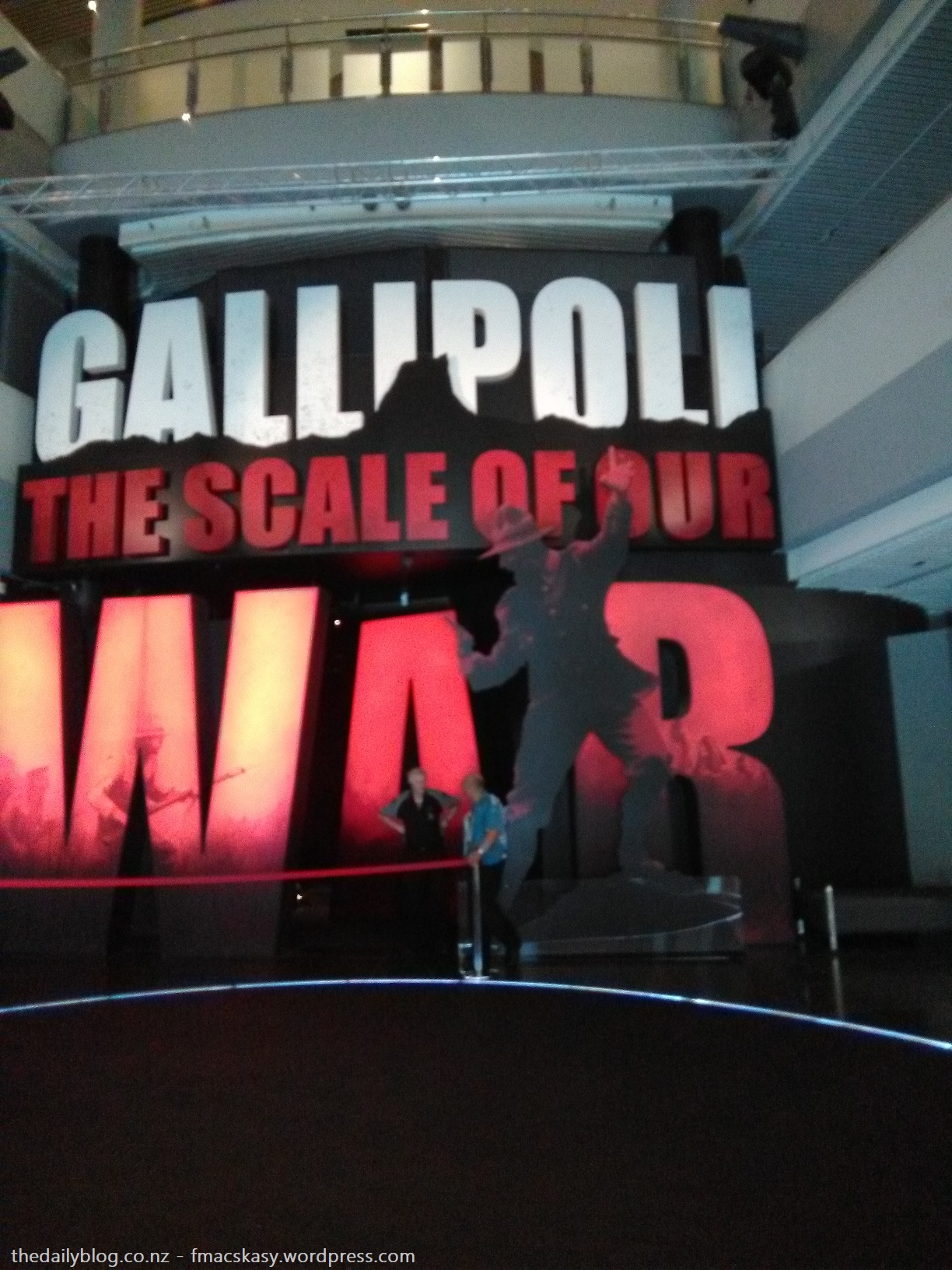
.
When first revealed to the public, Peter Jackson made great effort to ensure that the dual exhibitions were not to be perceived as a “glorification of war”;
“It’s not an anti-war museum, it’s certainly not a glorifying war museum. It is just showing the reality.”
Te Papa’s CEO, Rick Ellis, repeated the official ‘line’ that it was not a glorification;
It did not glorify war or shy away from questions around war.
But the depictions of the 2.4 times human scale figures of soldiers in various poses – from tragic weariness to stoic determination – raises questions surrounding those assertions. One particular aspect of the Te Papa display is deeply troubling when it’s implications are carefully considered.
For example, the “machine gunner” figure set in the diorama with a machine gun is depicted with a square-jawed, heroic pose;
.

.

.
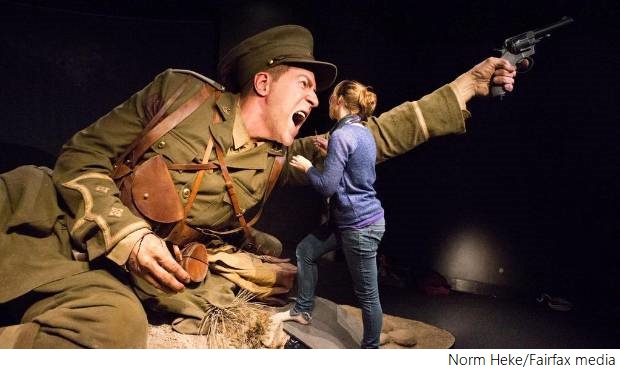
Jacqueline Makkee of Weta Workship, works on the model of Gallipoli soldier Spencer Westmacott.
.
They bear an uncanny resemblance to the gallant, valiant, clean-cut, stylised quasi-propaganda, shown in old ‘Commando‘ comics;
.

.
But perhaps the most disturbing aspect of the Te Papa is an interactive feature which invites members of the public to treat the roll of the sniper as a ‘game’. A precursor depiction to the ‘game’ revealed how some viewed sniping, contemporaneously;
.

.
To soldiers at the time, that may well have been a common attitude. If anything, the displays reinforces our notions of war as a bloody kill-or-be-killed conflict. There was no time to consider the ‘niceties’ of polite society.
But the next feature of the sniping display cannot be justified or explained away so easily.
Citizens of early 21st Century society were invited to “Have a Shot”;
“Periscope rifles let you shoot without sticking your head above the trench.”
.
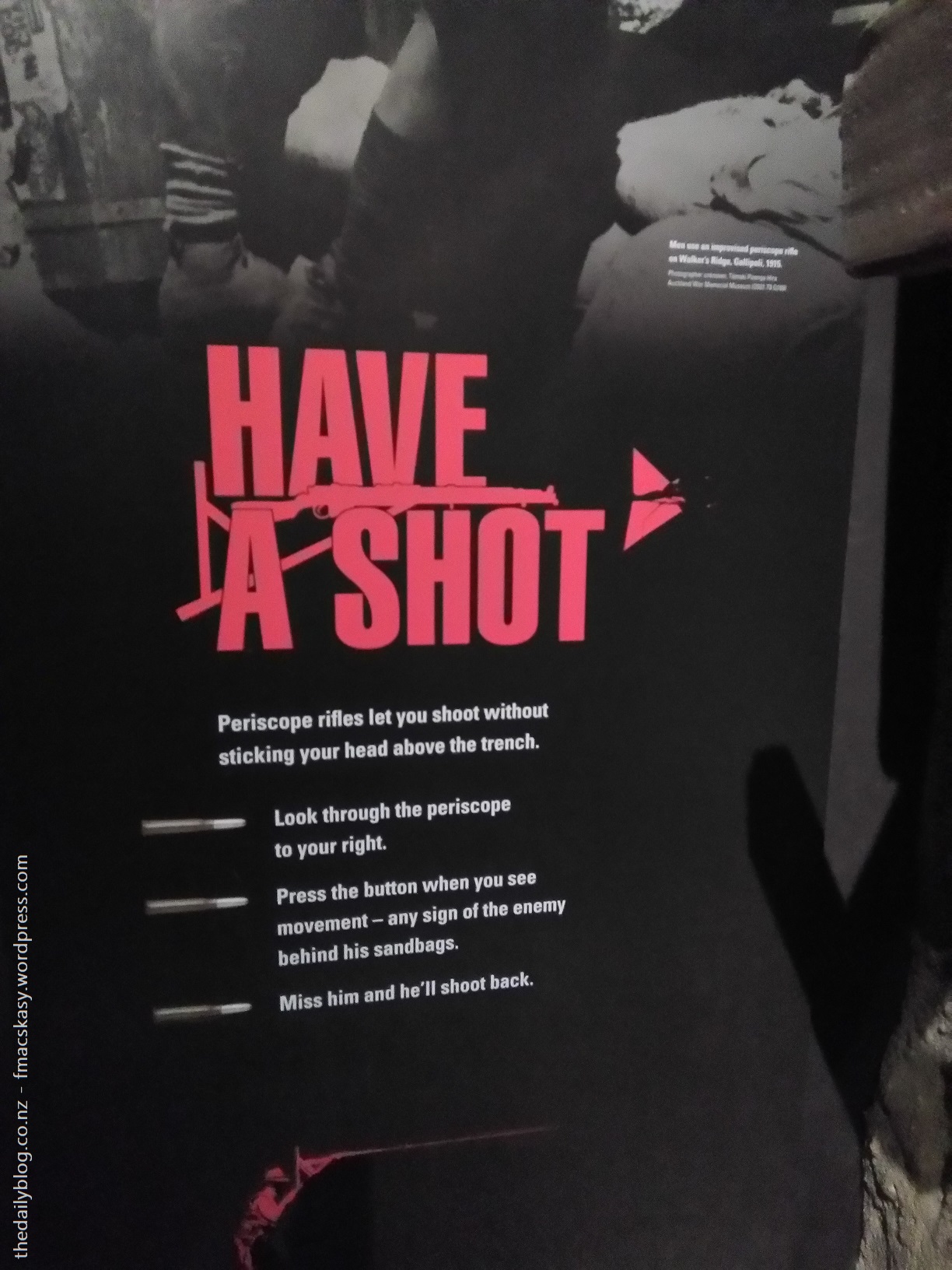
.
The following three “bullet points” were iconised with images of actual bullet cartridges;
— Look through the periscope to your right.
— Press the button when you see movement – any sign of the enemy behind his sandbags.
— Miss him and he’ll shoot back.
The little red button glowed invitingly;
.
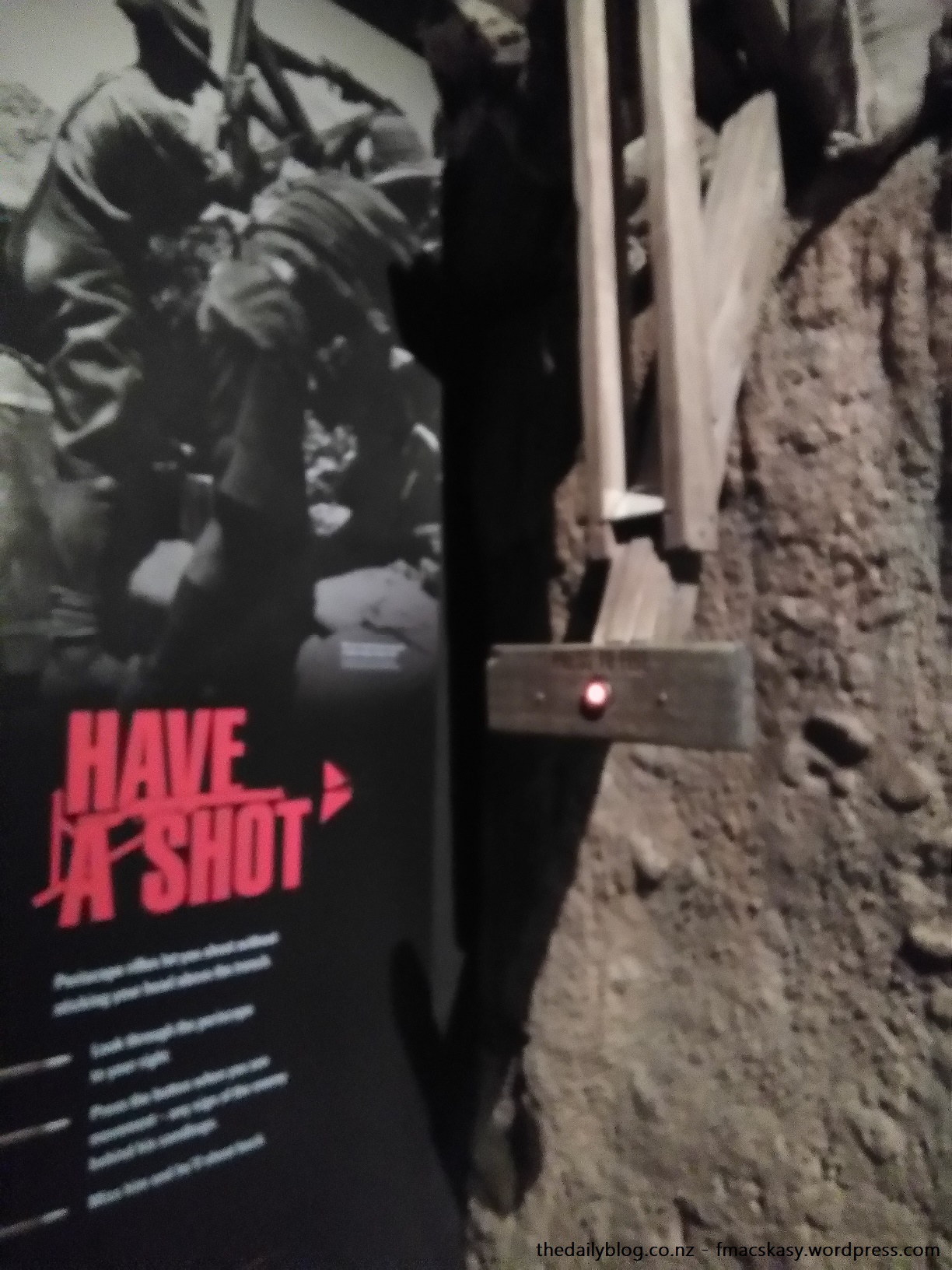
.
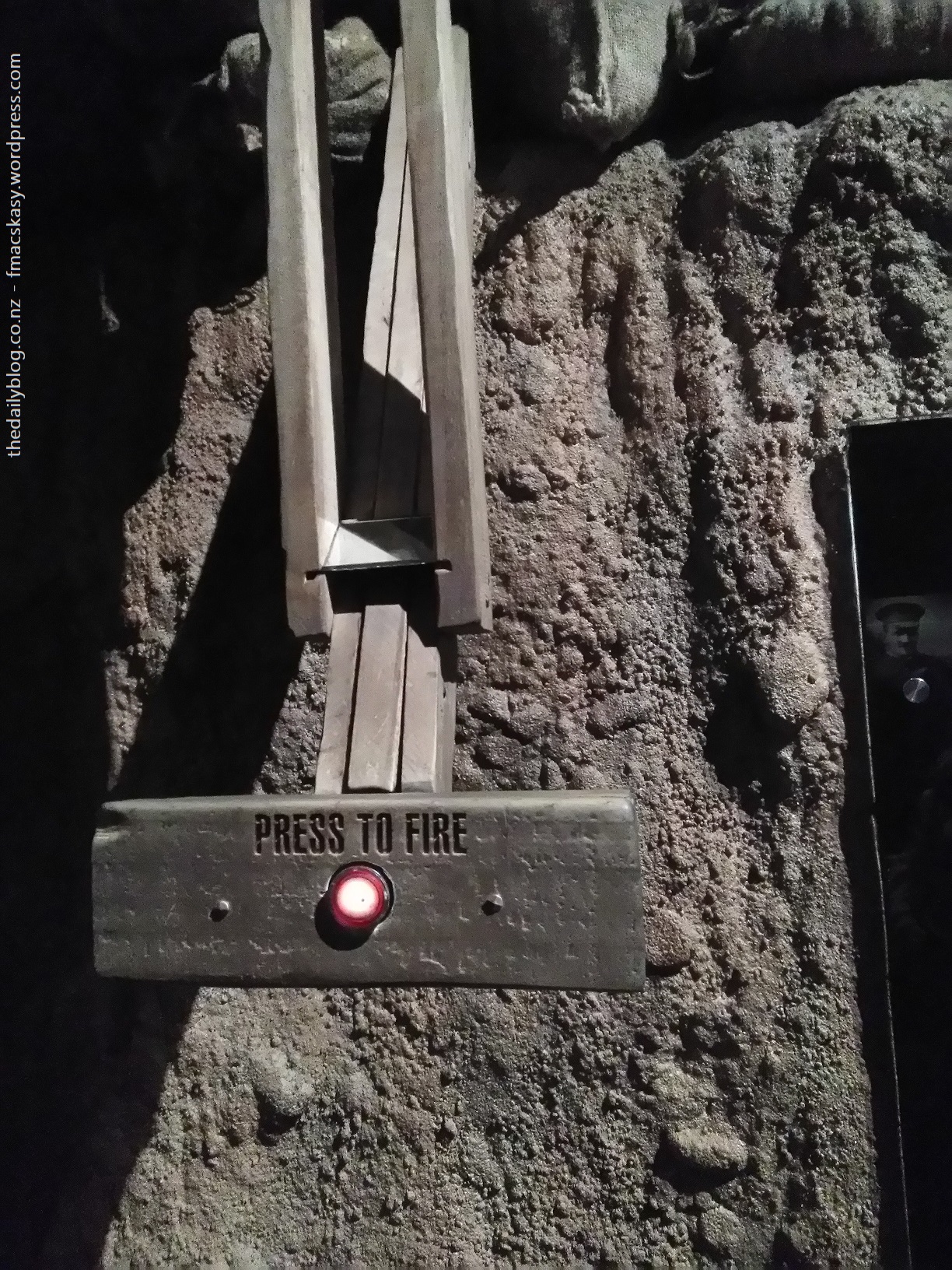
.
And perhaps unfortunately, there was no end to a line of members of the public who seemed to hold no qualms in treating the killing of another human being as a ‘game’;
.
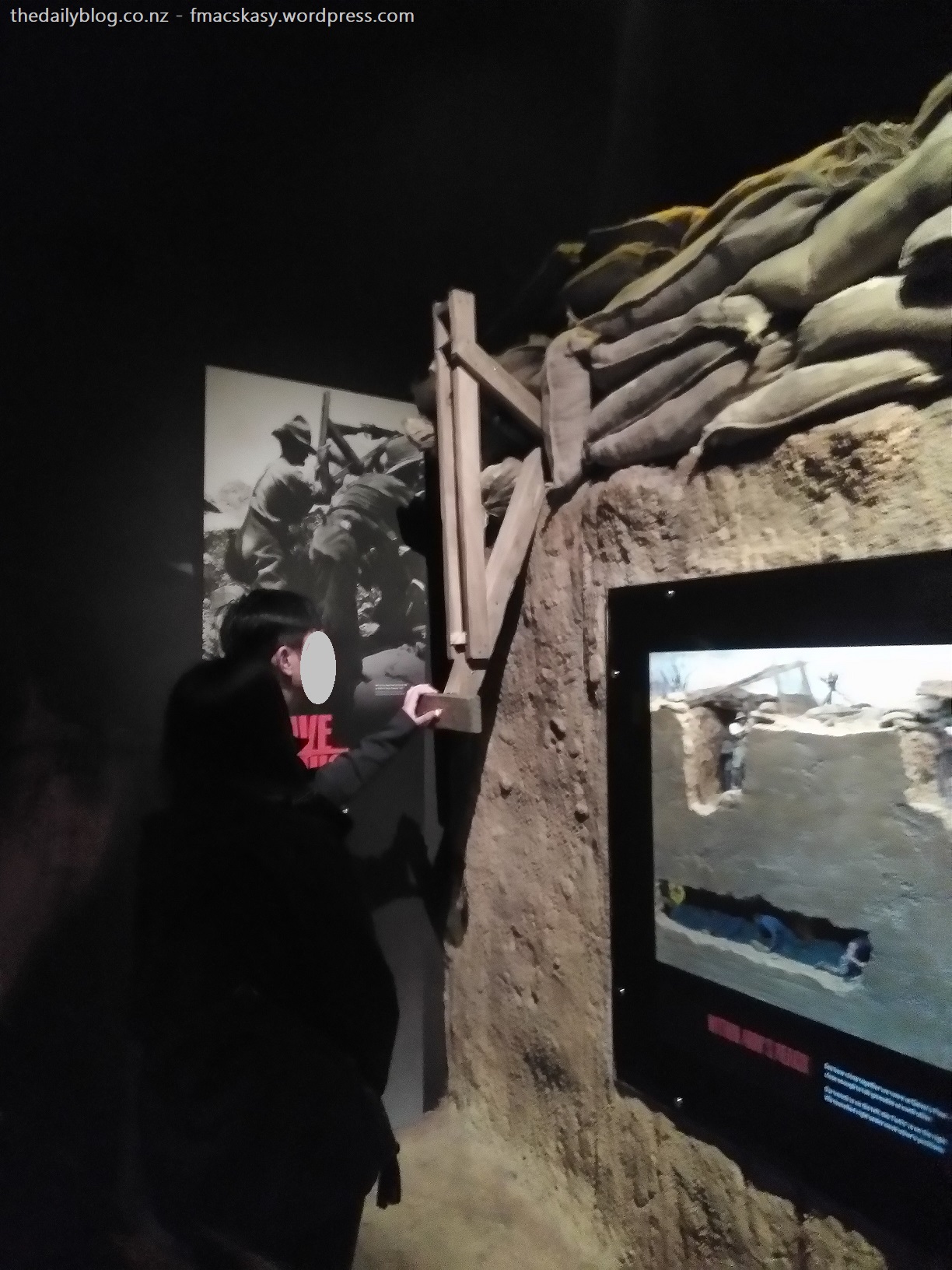
.
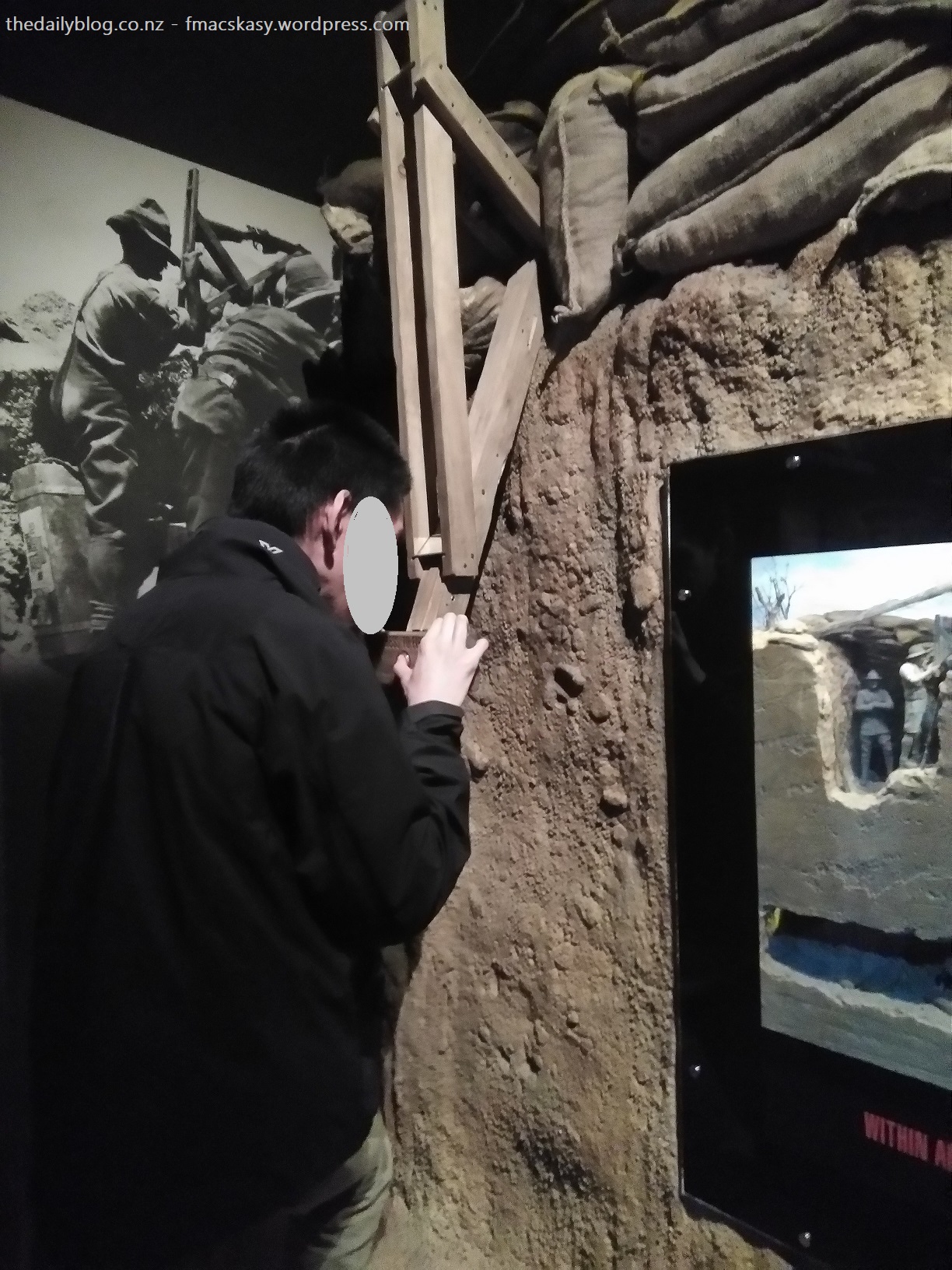
.

.

.
The creators of the exhibition have taken the mock-killings of internet/electronic gaming and applied it to the legitimacy of a museum setting. Mock killing has become mainstream courtesy of our local museum.
Which would seem to make a sham of exhibition creative director and Weta Workshop co-founder, Richard Taylor’s noble-sounding words when the exhibition was first opened to the masses;
“[We wanted to] give respect to memories on the scale that they deserve.
We hope when visitors leave this experience that they carry more wisdom so that the spirit and the sacrifices of these young men and women are never forgotten.”
Little wonder that there was criticism of the dual exhibitions, pointing out the subtle apparent-glorification of our ‘Great War’ dead. Writing for the World Socialist website, John Braddock and Tom Peters said;
As a junior partner of British imperialism, New Zealand’s ruling class joined WWI to expand its wealth and seize more Pacific island colonies. The invasion of German Samoa, which was New Zealand’s first action in WWI, is not mentioned in either of the Wellington exhibitions. In the course of the war, 18,500 New Zealanders died and 40,000 were injured, out of a population of about one million.
Both exhibitions are virtually silent on the widespread opposition to WWI internationally. The exception is a reference in the Great War Exhibition to opposition among the American working class, which delayed Washington’s entry into the war. The wall text then quotes US President Woodrow Wilson’s cynical declaration in April 1917 that “America would ‘make the world safe for democracy’ by joining ‘the war to end all wars.’”
There is no reference to the class struggles against conscription and war, including protests and mass strikes throughout the world. The upsurge prompted the 1916 founding of the NZ Labour Party by the trade unions, which aimed to divert the anti-war movement into safe parliamentary channels.
The Great War Exhibition makes no mention of the Russian Revolution. The overthrow of capitalism by the Russian working class, led by the Bolsheviks, inspired workers internationally and forced the warring powers to agree to an armistice to prevent the revolution from spreading. The display falsely presents the armistice as simply a military victory by the Allied powers.
They make a chilling observation;
The pro-war carnival taking place across Australia and New Zealand must be taken as a sharp warning. The contradictions of capitalism that caused WWI are once again intensifying. Successive New Zealand governments have strengthened the country’s alliance with US imperialism, which is stampeding from one bloody intervention to the next in the Middle East, while building up its military forces against Russia and China.
Messrs Braddock and Peters point out that “there is cursory acknowledgement of the Ottoman death toll—which numbered 86,692, more than 30 times New Zealand’s 2,779“.
Mr Jackson’s comments – reported above – take on a new ambivalence as to the meaning of the exhibitions;
“It’s not an anti-war museum, it’s certainly not a glorifying war museum. It is just showing the reality.”
Meanwhile, the exhibition makes a fleeting gesture to the magnanimity shown by the Ottoman/Turks toward an implacable foe invading their territory;
.

.
“Those heroes that shed their blood and lost their lives… are now lying in the soil of a friendly country… and are in peace…
They have become our sons as well.” – Mustafa Kemal Atatürk, commander of the Turkish 19th Division at Gallipoli and founder of the Turkish Republic, 1934
No mention of a Turkish museum-game to kill ANZAC soldiers.
In a 2016 thesis by Elizabeth Anne du Chateau Blackwell also pointed out;
Perhaps, when foot traffic counts, controversy is not welcome: war as a back-drop for noble action and attitude is likely more appealing to a wide audience than war as waste, war as hate, war as frustration and fear and anguish. Certainly, Gallipoli sets the ‘ordinariness’ of the national character against a view of war designed to arouse pride rather than highlighting its brutality and devastation or the changes it caused in Aotearoa-New Zealand.
The war is not a ninth character in Gallipoli, and it might have been. I called this section National pride and the glorification of war, but in fact, the exhibition does not glorify war so much as make it as ‘ordinary’ as the New Zealanders who fought there. It is not sanitised: it is simply accepted as taking place, and this is presents a disjoin for modern sensibilities. Setting aside the sentimental and cultural ties to Britain, a war in Europe, arguably, had little relevance to Aotearoa-New Zealand on the opposite side of the world, but it is in fact the sentimental and cultural ties that are elevated in Gallipoli.
Aotearoa-New Zealand, it seems, did a ‘right’ thing by sending troops and medical personnel to the war effort. Suffering is certainly presented, but it is objectified and put out for the wondering gaze of the visitors. Against the real stories of the eight real, but ‘ordinary’ New Zealanders, the exhibition offers no critique of the catalogue of escalating stupidity and unwise decisions made in relation to the campaign to take Gallipoli.
At a time when the current Labour-NZ First coalition government has voted to extend New Zealand’s military “mission” in Iraq,
.

.
– such questions of doing the “‘right’ thing by sending troops and medical personnel to the war effort” becomes even more critical.
If the exhibitions at Te Papa and the former Dominion Museum have made people think twice about the use of war as a political tool, then it may have served a purpose. Of all the things governments have the power to do – and must always be unrelentingly questioned – is their policy to engage in war.
If, as Ms Blackwell suggested, the exhibitions present war as “ordinary” and “simply accepted as taking place”, then it has become a form of desensitising propaganda. This may never have been the intentions of messrs Jackson, Taylor, and Ellis – but inviting members of the public to take a shot at a faceless enemy through a ‘game’ suggests otherwise.
At the very least it was unhelpful.
It was certainly disrespectful.
.
Note:
It will be interesting if the response from certain individuals associated with Te Papa will be as defensive and hostile as they were in a previous museum-related story.
.
.
.
References
Ministry of Culture and Heritage: Dominion Museuem
Fairfax media: Jackson’s Great War Exhibition unveiled in Wellington
NZ Herald: Gallipoli exhibition shows soldiers frozen in time
Fairfax media: Te Papa brings epic scale of World War I to life
Te Papa: Te Papa celebrates a record-breaking year
Fairfax: Sir Peter Jackson shows off his Great War Exhibition in Wellington
World Socialist Web Site: New Zealand’s WWI exhibitions falsify history and glorify war for a new generation
AUT: Gallipoli as Edutainment? Constructing national identity in a “new” museum
Newsroom: NZ’s ‘mission creep’ in Iraq creeps on
Other Blogs
World Socialist Web Site: New Zealand’s WWI exhibitions falsify history and glorify war for a new generation
Previous related blogposts
Copyright (c) Notice
All images stamped ‘thedailyblog.co.nz – fmacskasy.wordpress.com’ are freely available to be used, with following provisos,
» Use must be for non-commercial purposes.
» Where purpose of use is commercial, a donation to Child Poverty Action Group is requested.
» At all times, images must be used only in context, and not to denigrate individuals or groups.
» Acknowledgement of source is requested.
.
.
.

.
.
= fs =

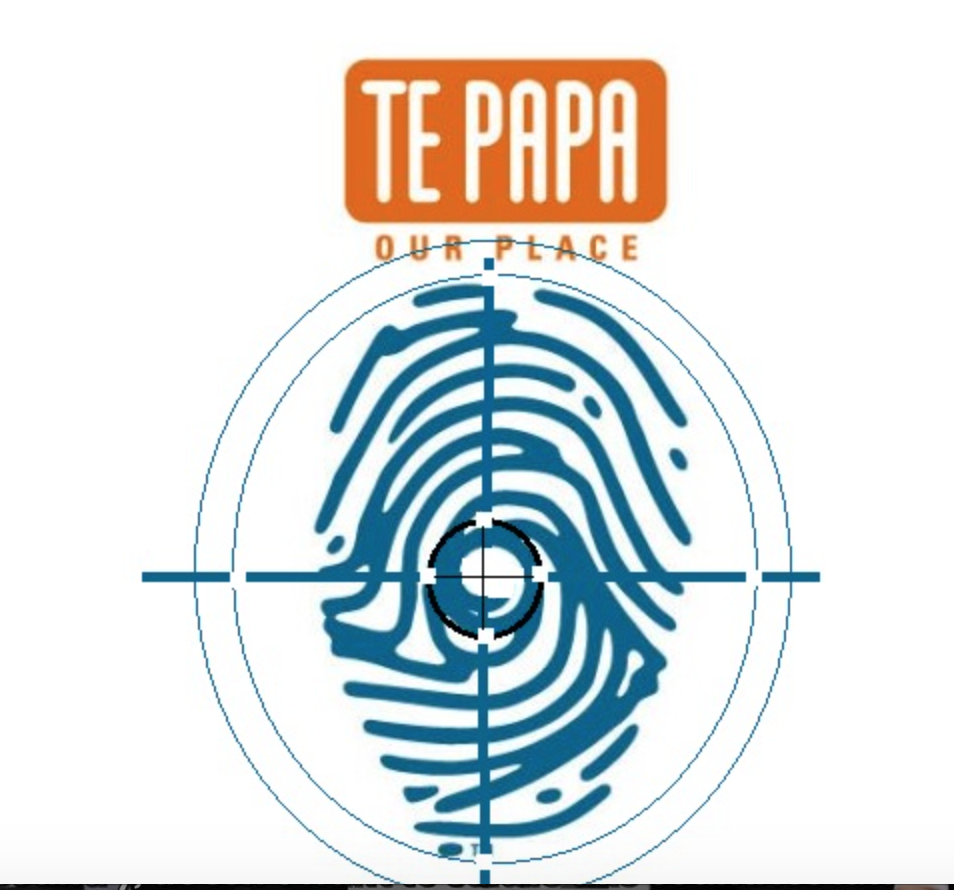
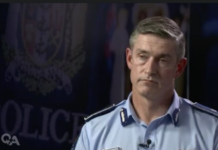



Is it just me or is WW1 the hook upon which the public hangs its hat for national pride and foreign relations even today.
Unfortunately not SAM, from my observations it would appear that the average New Zealander, seems to take pride that our armed forces are assisting the exceptional american war machine to murder people, men woman and children in there own country’s.
Nope, not just you, Sam. I think you’ved sussed it. It appears that Anzac Day is more and more our de facto “independence day”. Which in some ways is probably appropriate.
But how independent are we when we seem continually drawn into the American Empire’s neverending wars?.
Time to say “no more”.
Frank: the depiction of sniping to kill as a game is indeed troubling. What possessed Te Papa to include it, I wonder? And how would our Turkish friends view such an insensitive display? It should be tsken down immediatly.
Seems Hollywood did its job anyway, to promote the myth and mythology of the America empire. It’s always been the case that empires become progressively expensive to manage at the ends.
Re last photo. President Nixon often spoke about achieving “world peace”. I think this might have been a nod to the belief at the time that such a thing was possible, if if not the case when man landed on the moon. It’s quite possible and normal for ideals and realities that are quite opposite of each other to exist at the same time.
Thank you, Frank. This is awful. It may not be glorifying war, it may just be Jackson showing off again, but to make games derived from the tragedy of dead people’s histories is shocking. Nor can war ever be sanitised. Nor should it be.
In NZ, we have had small experience of war on our soil. NZ’ers
from places where wars have been fought, or who have lived and worked in such countries, or fought in them, struggle sometimes to find the vocabulary to talk about it.
If Jackson had lived and worked in Germany or France or Poland or Russia or Hungary or Korea or Cambodia or manywhere, or read the words of families with war-ravaged genes, he might be pondering whether an exhibition like this conditions viewers into accepting war as a normality, or as an inevitability, and whether this is a healthy way to be thinking.
Very well put, and timely Frank.
I used to do Anzac, but now that I am older and sadder, I cringe at seeing our youthful cadets standing so rigidly and correctly while the old lines of poetry get formally but unconvincingly read out, and the last Post starts to sound more like a salute to the heroic dead than a lament for the sadly fallen. The emphasis is now to salute heroism, with very little recognition of the needless loss of life. In fact, loss of life now = heroism.
It saddens me, so i no longer attend.
Vino, your comment is one of the most poignant I’ve ever read… Something about it speaks eloquently of your deep feelings on this matter.
On the RC memorial to former students of the school at Pukekaraka, Otaki, in the “1914 – 198 war”, the inscription refers to the fallen as “victims of the war”. That seems the right approach. Not the “Great War” etc. Lives were taken from households across the nation, breaking hearts like eggs. War is a crime against humanity.
Alistair
Frank, I completely agree: you’ve nailed it here. Thank you.
On previous blog posts, I’ve expressed my distaste for those exhibitions of Jackson’s.
My reasons are broadly the same as those which you’ve laid out here. I’d add that four of my uncles went away to that war; one came home. The remains of two of them are still at Gallipoli. Not graves: remains. The consequences of that loss reverberated through my family, and continue to do so, right up to the present.
If Jackson wants to mess about with larger-than-life displays, he should stick to dragons. Or those bloody eagles at the airport.
Actually, D’Esterre, it was something you said about the Te Papa exhibition that prompted a memory ‘flash’ of the “sniper’s game”. I went back to check to see if my mind wasn’t playing ‘tricks’ on me… Sure enough, there it was.
Calling the ‘game’ disrespectful was my revised phrasing. My first version was not quite so restrained.
Frank: “Calling the ‘game’ disrespectful was my revised phrasing. My first version was not quite so restrained.”
Heh! Let rip, say I. It is richly-deserved.
“…its implication…” You’re welcome 😉
well put Frank, WWI was an imperialist war pure and simple, nothing for anyone to be proud of really–let alone well off war fetishists like Lord Jackson indulging himself again
every hamlet in NZ seems to have an arch, wall, flagpole, or hall that notes those slaughtered and maimed, and given the low population at the time, one can appreciate why the memories are hardwired for some, it is interesting to note that after the initial surge of gung ho volunteers, conscription had to be introduced to keep the numbers up once stories of trench reality filtered back
the ANZAC mythology was mystery enough to me as a school kid, and was finally shattered for good when a massive undercount of NZ participation at Gallipoli, with a subsequent downgrading of the casualty count, was revealed recently…
https://www.radionz.co.nz/news/national/299592/nz's-true-gallipoli-numbers-revealed
I like the view above too, that the Bolshevik Revolution was a catalyst to the end of WWI
Comments are closed.